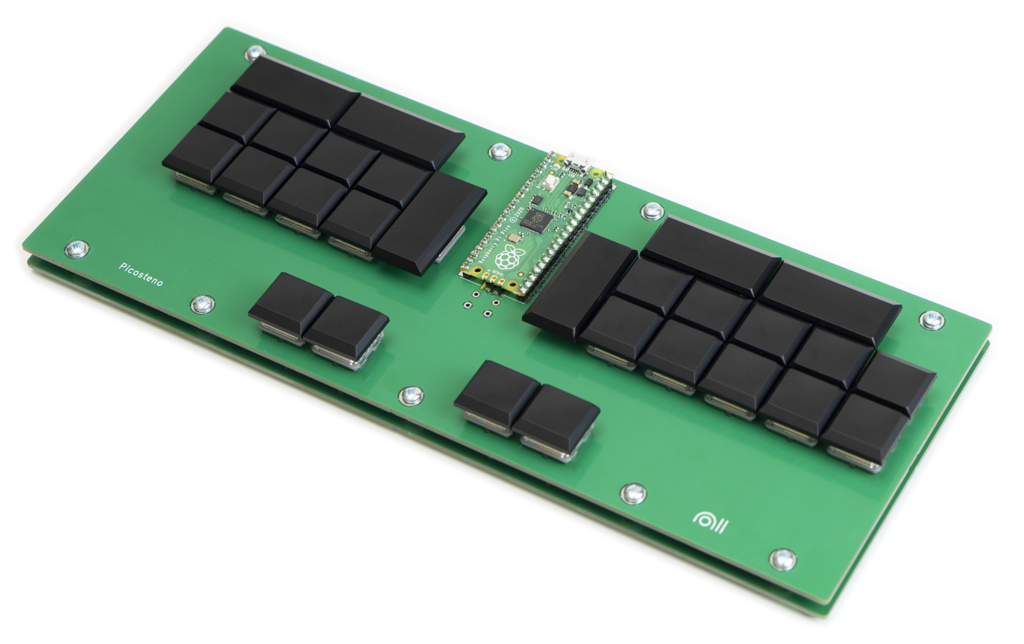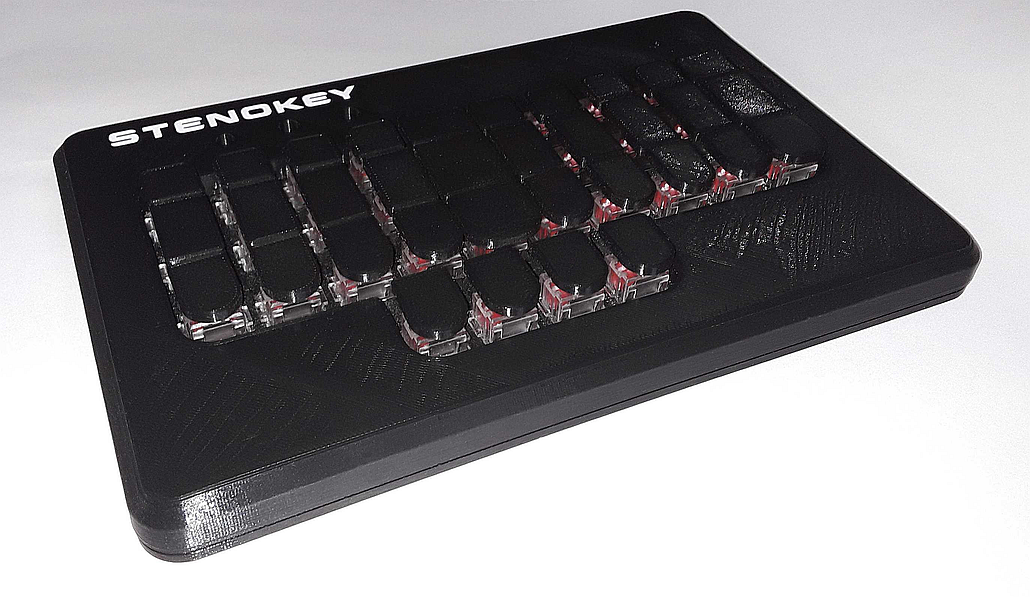DIY steno writers
DIY writers specifically for Plover
Projects to build your own machine.
| Product Name | About |
|---|---|
| MechWild BB Steno | 
A barebones keyboard kit from MechWild. Comes with a PCB ($10) and optional microcontroller (+$8) and a few other parts; you supply the switches and keycaps. |
| Picosteno | 
A full Steno kit from Nolltronics. Starting at $20 for the PCBs and mounting hardware and going up to $61 for everything you need, this is the cheapest board you can make! |
| Stenokey | 
Stenokey is an open-source do-it-yourself stenographic keyboard project. It is aimed at makers with some electronics experience (soldering) and who own a 3D printer or who have a friend with a 3D printer. |
| The Uni v2 PCB | 
The Uni v2 PCB, instructions in the description. Some prior experience is recommended. Only comes with a PCB and has pre-soldered diodes. |
| Yet Another Steno Keyboard | 
YASK is an easy-to-build open-source design for a steno keyboard. Simple, no 3D printing needed, also exists in angled & staggered version. Check out the build instructions |
Which type of key switch should I choose?
Due to how multiple keys must be pressed simultaneously, there are two properties that are useful to have in a mechanical keyboard switch for steno: a light actuation force on a linear switch.
The light actuation makes it easier on your hands. For a chord like TKPWHRAOEUGD (gliding), you are hitting 8 keys with your left hand. That means that whatever switch force you need to depress one key, you have to push 8-times as much. For a 80cN (~80 grams, ~2.9 oz) switch, that’s 640cN (~640g, ~22.6 oz). For this reason, your wrists will have a much easier time working with your machine if its actuation force is as light as possible.
| How many keys are in the average chord? | |
|---|---|
| 1: 23 2: 221 3: 1115 4: 3247 5: 6168 6: 7820 7: 7293 8: 5069 9: 2707 10: 1126 11: 331 12: 90 13: 21 14: 3 15: 1 |

|
The linearity is recommended because it’s been found that the tactile feedback that one gets from an individual switch is not as useful when you are receiving 4-10 of those feedbacks at once. The brain just doesn’t process all the fingers’ feedback in a useful manner. And since the bump usually requires a small addition to the actuation force, we recommend keeping it linear and simple.
Professional steno machines, historically, always bottomed out (meaning the keys are pressed until they can no longer travel; the bottom.) Newer machines use more complicated mechanisms for detecting key travel, often using magnets and the hall effect to determine where the key is, allowing for customizable actuation points. The typical force required for a modern steno machine is between 10cN and 20cN, with some extremes on either end for personal preference. The travel of a typical lever steno machine is usually between 2mm and 30mm. The lower end is found in machines like the LightSpeed (nonlever), where the higher end is around the maximum that you can configure a lever machine to stroke.
Most of the mechanical switches have a 2mm actuation point and 4mm travel/bottoming out, but some community members have found that “speed switches” with an earlier actuation point (usually 1.1-1.4mm) are better for steno due to their increased sensitivity.
| Switch | Stat | Note | Machines |
|---|---|---|---|
| Kailh Choc Pink Pro | 20 cN linear | The lightest stock option available, though the reduced travel distance makes it feel comparatively heavier | All Nolltronics boards and the Starboard use this switch |
| Kailh Choc Nocturnal | 20 cN linear, silent | ||
| Gateron Clear / White | 35 cN linear | A popular stock option available on the market | All StenoKeyboards boards and the TinyMod use this switch |
| Matias Red | 35 cN linear | Feels heavier than 35 cN switches due to having a “flat” force curve. Matias also has a different stem from Cherry | SOFT/HRUF uses this switch |
| Cherry MX Red | 45 cN linear | ||
| Kailh Silver | 50 cN spring* linear | Has an early actuation (1.1mm vs 2mm) | |
| Cherry MX Brown | 45 cN bumpy | While not ideal compared to other options, this switch is still a better choice than blues, blacks, and other Cherry switches | |
| Kailh Choc Red | 50 cN spring* linear | The Georgi uses this switch |
- The Kailh silvers and Choc reds use a spring that would cause a 50 cN actuation point at 2mm, but since they actuate earlier (1.1mm), the force required is nearer to 35 cN.
There are other methods to decrease actuation force for even these switches. This includes:
- Putting SPRiT 15g Choc springs into the Kailh Choc Pink Pro
- Putting the Gateron Clear’s 35 cN spring into the Kailh Silver for its earlier actuation point.
- Trimming the springs of a linear switch by several mm to reduce force.
- Using an aftermarket spring with lower forces, such as a prototype 20 cN spring that isn’t yet released to the wider market.
- Removing the leaf-spring (not the primary spring) in the Matias Red switch to make the force curve less flat.
NKRO keyboards with an ortholinear layout
Keyboards with an “ortholinear” layout have the keys in straight columns. This is handy for steno, as it makes it easier to press two keys in a column with a single finger.
The following machines have been confirmed by users to work with Plover after actually trying it:
| Product Name | Manufacturer | Protocol/Connection | Comments |
|---|---|---|---|
| ErgoDox | ErgodoxEZ, Massdrop, FalbaTech, others | USB | The ErgoDox is a fairly high-end NKRO keyboard at $200, with an ortholinear layout. It has two separate halves, so you can angle them to suit you. You can order it with the Gateron White keys, which have an extremely light, 35 gram activation force. Read a guide to Starting Stenography with an Ergodox by Paul Fioravanti. |
| Planck | OLKB | USB | The Planck is a fully programmable NKRO keyboard with an ortholinear layout. It is 40% the size of a standard keyboard. Read a guide to starting stenography with a Planck by DiDoesDigital. 
|
| Preonic | OLKB | USB | The Preonic is a fully programmable NKRO keyboard with an ortholinear layout. It is 50% the size of a standard keyboard. |
| Gherkin | USB | The Gherkin is a fully programmable NKRO keyboard with an ortholinear layout. It is 30% the size of a standard keyboard. | |
| Iris | Keebio | USB | The Iris is a cheaper and slightly smaller alternative to the ErgoDox. It is a fully programmable split NKRO keyboard with 56 keys. The firmware needs to be edited to enable either NKRO or Gemini PR. Available in PCB and pre-built. |